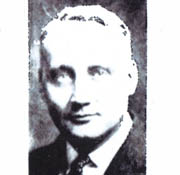Spokane architect Charles Irving Carpenter was born in Chicago in 1888. His formal training, if any is unknown. He arrived in Spokane via Chicago in 1912 and initially was an instructor at North Central High School. Shortly thereafter he reportedly served as superintendent of buildings and grounds for Spokane public School system. During WWI he served in the Army Air Service, production branch.
After the war, in 1919, he joined the older and more experienced Karl G. Malmgren (former partner of well-known architect Kirtland K. Cutter), in a new architectural partnership. Both men received their architectural licenses that year; the year the state first began to award such licenses. After Malmgren died of throat cancer on May 21, 1921 at the age of 58, Carpenter continued an independent practice.
Over the course of his career, he reportedly designed a variety of building types including courthouses, schools, dwellings, lodge buildings, and city halls and his projects were touted good, timeless designs by the local newspaper.
Carpenter’s work found favor on the Central Washington University Campus in Ellensburg, where he designed numerous projects on campus over a ten-year time span. Projects included an addition and interior renovations to Kamola Hall (1919, 1922); Sue Lombard (1927) and Munson dormitory halls (1927); the library / Smyser Hall (1926); the Samuelson Student Union Building (1929); and an addition to the main administration building (1935).
Other educational projects included a 16-room schoolhouse in Wrangel, Alaska (1931); Martin Hall at Eastern Washington University (1938, with George Rasque); an addition to West Valley High School in Millwood (1937); and his last project before his death, Moscow High School (1938) in Moscow, Idaho.
Other known projects include the Elks Lodge in Wallace, ID (1924) and Ellensburg (1924); Portfors Motor Co. Garage (1928) in Spokane; the Clearwater Co. Courthouse (1929) in Orofino, Idaho; the Sigma Alpha Epsilon Fraternity House (1932) in Moscow, Idaho; and the G.O. Rogers House (1936) in Spokane.
Carpenter lived in the Breslin Apartments for most of his career and did not get married until late in life at the age of 41 in 1926. His wife, Carrie D. Hitchock was a school teacher.
He was active in fraternal circles and was a member of the Masons and Elks and American Legion Post No. 9. Respected by his peers he also served as secretary and treasurer of the Spokane Society of Architects (1936), an alternative organizations to the AIA.
Carpenter died suddenly at the height of his career after a short illness on December 25, 1938 and is buried at Riverside Park Cemetery in Spokane. While his known projects are limited, his death was reported in the Spokane as well as Seattle, each of which noted that he was an important pioneer architect in Eastern Washington and Northern Idaho.
By Michael Houser, State Architectural Historian - January 2017





